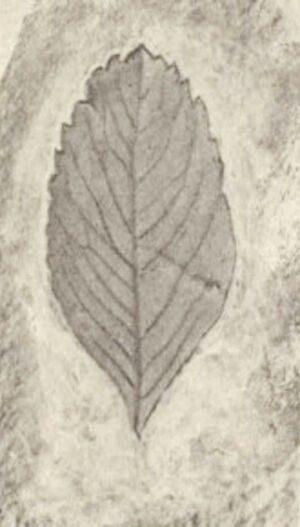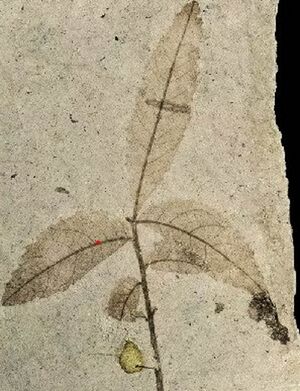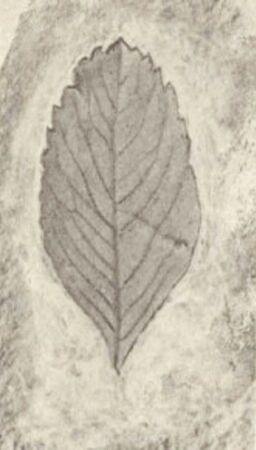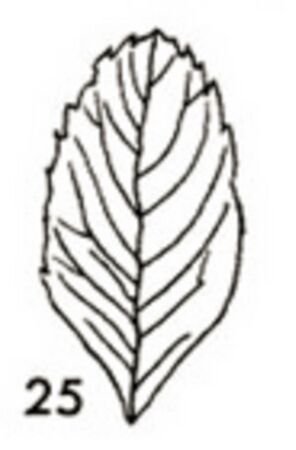Rosa harneyana R.W.Chaney et Axelrod
Fossile-Rose, 1959 - beschrieben von den Botanikern/ described by the botanists/ décrit par les botanistes Ralph Works Chaney, USA und Daniel Isaac Axelrod, USA
Eltern/ parentage/ parents: Botanische Rose/ Wild Rose/ Rosier botanique
Vermutliche Synonyme/ Presumed synonyms/ synonymes présumés: Rosa hilliae Lesq., Rosa dubia C.O.Weber
Die Synonyme wurden beschrieben von den Botanikern/ The synonyms were described by the botanists/ Les synonymes ont été décrits par les botanistes Daniel Isaac Axelrod, USA, Shigeru Miki, Japan, Hermann Engelhardt, Deutschland, Charles Arthur Hollick, USA, Ralph Works Chaney, USA, Frank Hall Knowlton, USA, Gábor (Gabriel) Andreánszky, Ungarn, Oswald von Heer, Schweiz, Theodore Dru Alison Cockerell, USA, Hsen Hsu Hu, China, Toshimasa Tanai, Japan, Władysław Szafer, Polen
Allgemeines • Preface • Remarques
Dies sind fossile Blattfunde aus dem Westen der heutigen USA, aus dem Miozän[1], also 5,33 - 23,03 Mio Jahre alt. Sie ähneln Rosa hilliae Lesq., zeigen aber kleine Unterschiede. Die Rosen besiedelten Bachufer und feuchte Wälder, besaßen also offenbar ein Gen, dass heute nur noch in einer Form von Rosa clinophylla Thory in Indien erhalten ist, die in Flüssen wächst.
These are leaf fossils from the west of what is now the USA, from the Miocene[1], i.e. 5.33 - 23.03 million years old. They are similar to Rosa hilliae Lesq. but show small differences. The roses colonised the banks of streams and damp forests, so apparently possessed a gene that is only preserved today in a form of Rosa clinophylla Thory in India, which grows in rivers.
Il s'agit de fossiles de feuilles de l'ouest des États-Unis actuels, datant du Miocène[1], c'est-à-dire de 5,33 à 23,03 millions d'années. Elles ressemblent à Rosa hilliae Lesq., mais présentent de petites différences. Les roses colonisaient les rives des ruisseaux et les forêts humides, elles possédaient donc apparemment un gène qui n'est plus conservé aujourd'hui que dans une forme de Rosa clinophylla Thory en Inde, qui pousse dans les rivières.
Originale Beschreibung • Original description • Description originale
Übersetzung:
Rosa harneyana new species
(Plate 37, figure 4)
Rosa hilliae Lesquereux. MacGlnltie, Carnegie Inst. Wash. Pub. 416, p. 57, 1933.
LaMotte, Carnegie Inst. Wash. Pub. 455, p. 132, 1936.
Umbellularia lanceolata Berry. LaMotte, Carnegie Inst. Wash. Pub. 455, p. 127 (part), 1936.
Als Grundlage für die folgende Beschreibung dienen ein einzelnes Blättchen in der Flora von Stinking Water und Blättchen ähnlichen Typs in den Flora von Trout Creek und Upper Cedarville.
Beschreibung. Fiederblättchen eiförmig bis elliptisch, oben und unten spitz zulaufend; Länge 2,5 bis 3,8 cm, im Durchschnitt etwa 3,0 cm, Breite 1,4 bis 2,0 cm, Breite 1,4 bis 2,0 cm, meist durchschnittlich etwa 1,5 cm; Blattstiel fest, 2 bis 5 mm lang; Mittelrippe fest, gerade und oben spitz zulaufend; 6 bis 8 dünne, schwankende Nebenblätter, deren Zwischenblätter meist in einem Winkel von 30° bis 40° divergieren und sich innerhalb des Randes nach oben schlingen, wobei sie die Randzähne mit dünnen und schwankenden Tertiärblättern versorgen, die oben mit den Nebenblättern durch eine breite Schlaufe aus Tertiärkaliber verbunden sind; Tertiärblätter unregelmäßig und ziemlich ausgeprägt; Rand gesägt; Textur mitteldünn.
Diskussion. Rosa ist jetzt in einer Reihe von fossilen Floren im Westen der Vereinigten Staaten bekannt, darunter Florissant, Gray's Ranch, Tehachapi, Alvord Creek, Neroly und Elko. Rosa hilliae Lesquereux ist in den Florissant-, Gray's Ranch- und Neroly-Flora vorhanden. Chaney (1927, S. 123) hat Gründe erörtert, die dafür sprechen, die Florissant R. scudderi Cockerell und R. wilmattae Cockerell als wahrscheinlich identisch mit R. hilliae anzusehen, und MacGinitie (1953, S. 121) stimmt dieser Zuordnung zu. Rosa hilliae unterscheidet sich von R. harneyana vor allem dadurch, dass sie eine abgerundete statt eine keilförmige Basis hat. Es ist klar, dass eine spezifische Unterscheidung der modernen Rosa-Fiederblättchen kaum möglich ist, und auch unsere Art könnte sich im Lichte des reichhaltigeren Materials als nicht von R. hilliae unterscheidbar erweisen. Dennoch gibt es keinen Grund für die Annahme, dass im Miozän nur eine einzige Rosa-Art Bachufer und feuchte Wälder besiedelte. Da die Exemplare aus den Floren von Stinking Water, Trout Creek und Upper Cedarville einander ähnlicher sind als Rosa hilliae, glauben wir, dass R. harneyana eine gültige Art ist.
Original:
Rosa harneyana new species
(Plate 37, figure 4)
Rosa hilliae Lesquereux. MacGlnltie, Carnegie Inst. Wash. Pub. 416, p. 57, 1933.
LaMotte, Carnegie Inst. Wash. Pub. 455, p. 132, 1936.
Umbellularia lanceolata Berry. LaMotte, Carnegie Inst. Wash. Pub. 455, p. 127 (part), 1936.
A single leaflet in the Stinking Water flora and leaflets of similar type In the Trout Creek and Upper Cedarville floras are used as a basis for the following description.
Description. Leaflets ovate to elliptic, subacute above and below; length 2.5 to 3.8 cm., averaging about 3.0 cm., width 1.4 to 2.0 cm., mostly averaging about 1.5 cm.; petiolule firm, 2 to 5 mm. long; midrib firm, straight, and tapering above; 6 to 8 thin, wavering secondaries, with intersecondaries, mostly diverging at 30° to 40°, looping upward within the margin, supplying thin and wavering tertiaries to the marginal teeth, joining secondaries above by a wide loop of tertiary caliber; tertiaries irregular and rather prominent; margin serrate; texture medium thin.
Discussion. Rosa is now known in a number of fossil floras In the western United States, including the Florissant, Gray's Ranch, Tehachapi, Alvord Creek, Neroly, and Elko. Rosa hilliae Lesquereux is present in the Florissant, Gray's Ranch, and Neroly floras. Chaney (1927, p. 123) has discussed reasons for considering the Florissant R. scudderi Cockerell and R. wilmattae Cockerell as probably identical with R. hilliae, and MacGinitie (1953, p. 121) concurs In this assignment. Rosa hilliae differs from R. harneyana chiefly In having a rounded rather than a cuneate base. It is realized that specific separation of modern Rosa leaflets is hardly possible, and similarly our species may prove not to be distinct from R. hilliae in the light of more abundant material. Yet there is no reason for assuming that only one species of Rosa occupied stream banks and moist woods in the Miocene. Since the specimens from the Stinking Water, Trout Creek, and Upper Cedarville floras resemble one another more nearly than they do Rosa hilliae, we believe R. harneyana to be a valid species.
Traduction:
Rosa harneyana new species
(Plate 37, figure 4)
Rosa hilliae Lesquereux. MacGlnltie, Carnegie Inst. Wash. Pub. 416, p. 57, 1933.
LaMotte, Carnegie Inst. Wash. Pub. 455, p. 132, 1936.
Umbellularia lanceolata Berry. LaMotte, Carnegie Inst. Wash. Pub. 455, p. 127 (part), 1936.
Une seule foliole de la flore de Stinking Water et des folioles de même type dans les flores de Trout Creek et de Upper Cedarville servent de base à la description suivante.
Description. Folioles ovales à elliptiques, subaiguës dessus et dessous ; longueur de 2,5 à 3,8 cm, en moyenne 3,0 cm, largeur de 1,4 à 2,0 cm, en moyenne 1,5 cm, le plus souvent en moyenne 1,5 cm ; pétiolule ferme, 2 à 5 mm de long ; nervure centrale ferme, droite et effilée au-dessus ; 6 à 8 secondaires minces et ondulées, avec des intersecondaires, le plus souvent divergentes à 30° à 40°, en boucle vers le haut à l'intérieur de la marge, fournissant des tertiaires minces et ondulées aux dents marginales, rejoignant les secondaires au-dessus par une large boucle de calibre tertiaire ; tertiaires irrégulières et assez proéminentes ; marge dentelée ; texture moyennement fine.
Discussion. Rosa est maintenant connue dans un certain nombre de flores fossiles de l'ouest des États-Unis, y compris celles de Florissant, Gray's Ranch, Tehachapi, Alvord Creek, Neroly et Elko. Rosa hilliae Lesquereux est présente dans les flores de Florissant, Gray's Ranch et Neroly. Chaney (1927, p. 123) a exposé les raisons pour lesquelles les R. scudderi Cockerell et R. wilmattae Cockerell de Florissant sont probablement identiques à R. hilliae, et MacGinitie (1953, p. 121) est d'accord avec cette attribution. Rosa hilliae diffère de R. harneyana principalement par sa base arrondie plutôt que cunéiforme. On se rend compte que la séparation spécifique des folioles de Rosa modernes est difficilement réalisable.
Il est évident que la séparation spécifique des folioles modernes de Rosa n'est guère possible, et de la même manière notre espèce peut s'avérer ne pas être distincte de R. hilliae à la lumière d'un matériel plus abondant. Cependant, il n'y a aucune raison de supposer qu'une seule espèce de Rosa occupait les rives des cours d'eau et les bois humides au Miocène. Comme les spécimens des flores de Stinking Water, Trout Creek et Upper Cedarville se ressemblent plus qu'ils ne ressemblent à Rosa hilliae, nous pensons que R. harneyana est une espèce valide.
Fundort • Find location • Lieu de découverte
Gefunden wurde das fossile Blatt von Rosa harneyana am Stinking Water[2] und Blättchen ähnlichen Typs in den Flora von Trout Creek[3] und Upper Cedarville[4].
The fossilised leaflet of Rosa harneyana was found at Stinking Water[2] and leaflets of a similar type were found in the flora of Trout Creek[3] and Upper Cedarville[4].
La feuille fossile de Rosa harneyana a été trouvée à Stinking Water[2] et des feuilles de type similaire ont été trouvées dans la flore de Trout Creek[3] et Upper Cedarville[4].
- Rosa harneyana
Zum Vergrößern anklicken • click to enlarge • cliquez pour agrandir
↑ Nach oben • Top • Vers le haut ↑
Einzelnachweis • Footnotes • Notes
Weblinks • External links • Liens externes
Literatur • Literature • Littérature
- R. W. Chaney & Daniel I. Axelrod, Miocene Floras of the Columbia Plateau, 1959 Seite 186 - Text u. Pl. 37, Fig. 4
- Herman F. Becker, The fossil record of the genus Rosa, 1963 Seite 6 - Text u. Seite 12 - Fig. 25



